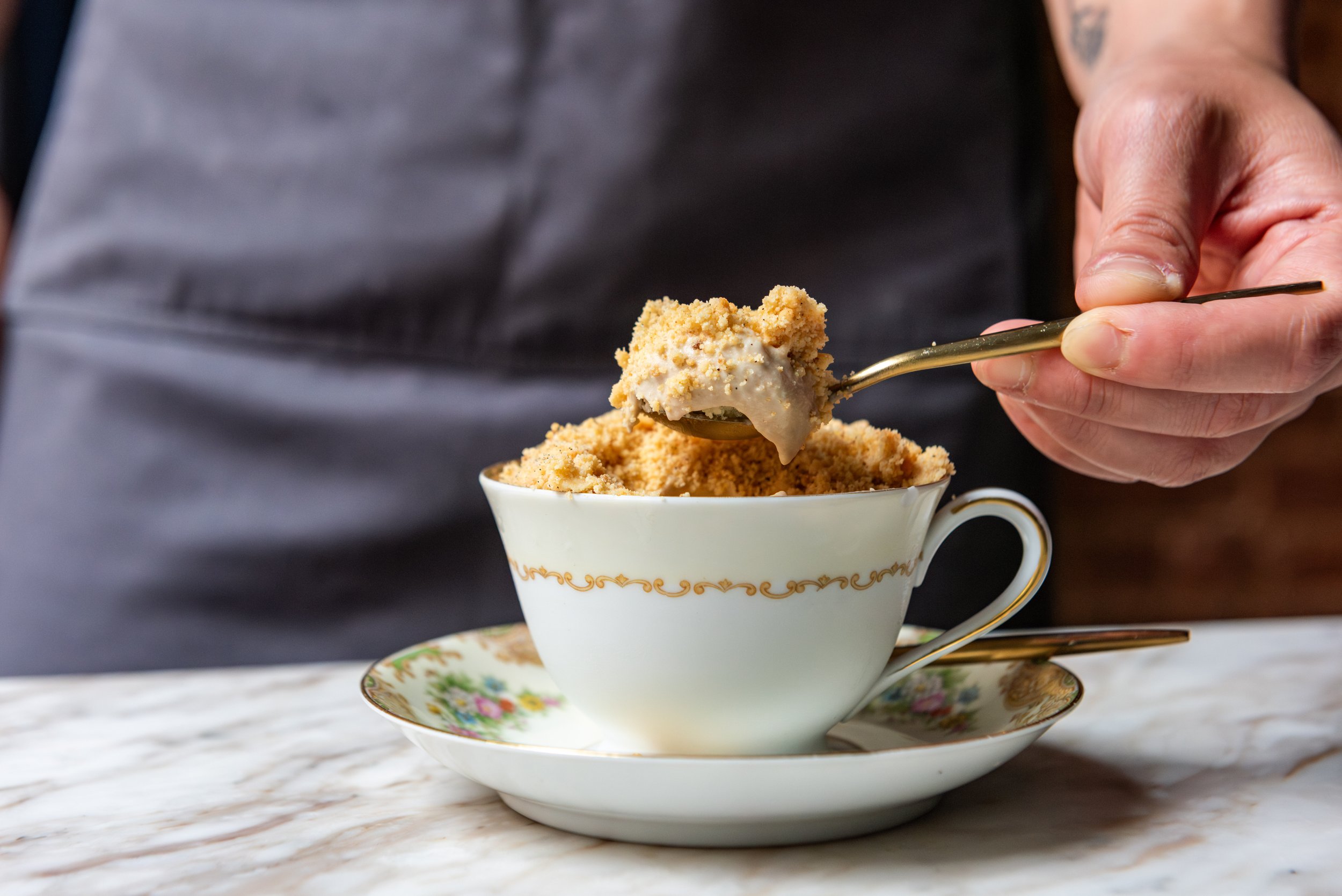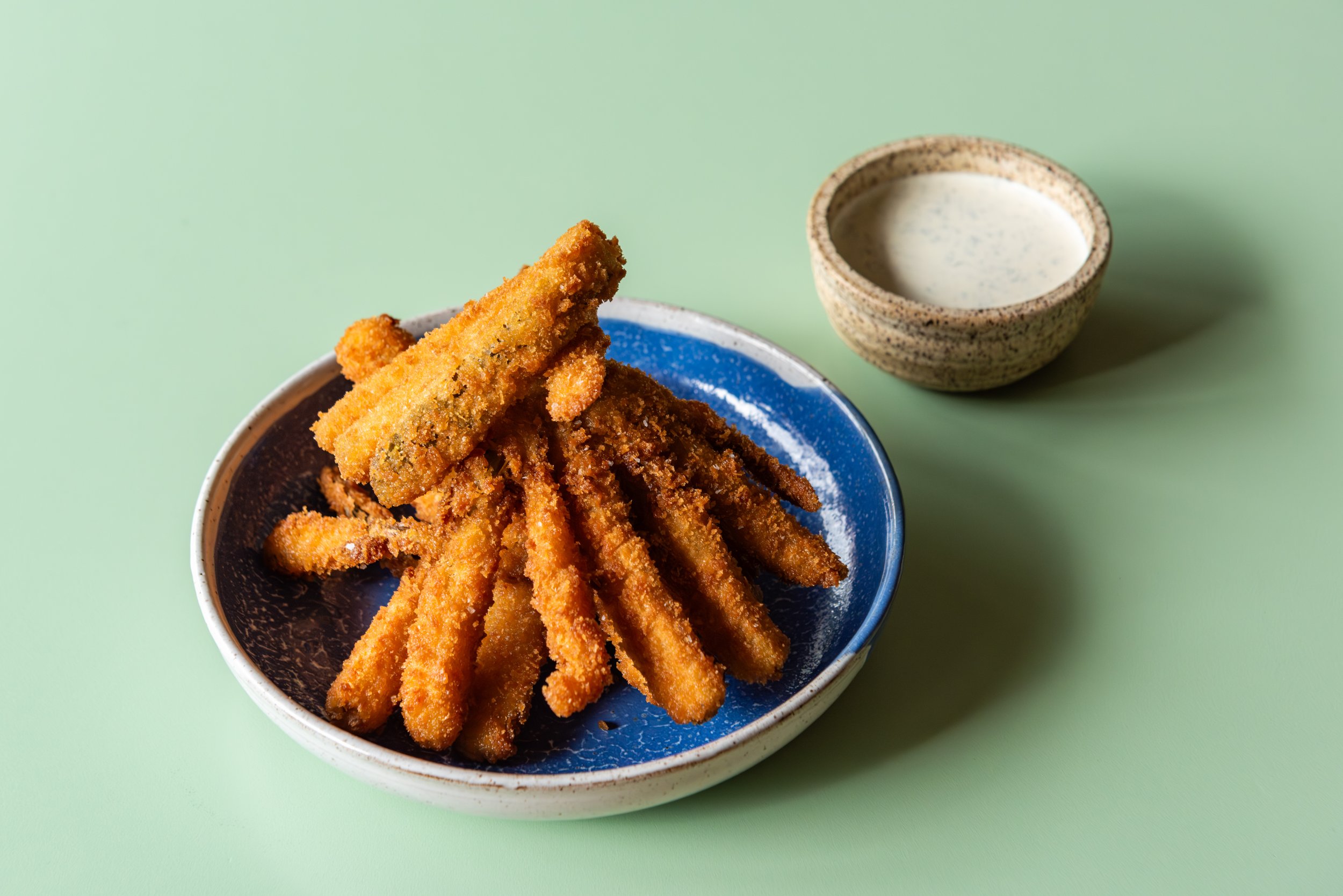2024 Charleston-Savannah Kitchen Notebook
An in-depth look at some of our favorite dishes and cocktails from our time on the ground in the Lowcountry.
Smashed Fried Chicken
“The smashed fried chicken goes back to my childhood,” says Chef Juan Stevenson. In the South, “we are very well known for fried chicken,” he says, “but there is an Indonesian dish—two dishes actually—of fried chicken: ayam penyet and ayam geprek. The last means crushed chicken.” While putting together the menu for his pop-up, JuJu’s Street Eats, Stevenson drew from his childhood memories of these Indonesian classics, as well as his experiences in American, Thai, and Korean kitchens, to create his ideal fried chicken. Boneless skinless chicken thighs are pounded until tender before they are brined overnight and marinated in oyster sauce, fish sauce, aromatics, and a mixture of toasted spices including white and black pepper, coriander, cumin, nutmeg, and turmeric; what Stevenson calls, “chicken dust.” On pick-up, Stevenson coats the thighs in a mixture of cornstarch, rice flour, and more “chicken dust” to create “that crispy outer skin” and give the meat “those crackles and ridges.” After it’s fried, the chicken is sprinkled with one last bit of “chicken dust” before it’s served with Bibb lettuce, tiger salad, and a tomato sambal-nước chấm chay dipping sauce. “It's who I am as a chef. I'm not afraid to bring cultures together because I am a product of colonization and globalization.” says Stevenson. “These experiences are something worth sharing, something I know hasn't been offered yet in Savannah.”
Marsh Loaf
With easy access to great grains—locally grown and milled—Baker Brandon McDaniel started Brandon’s Bread to showcase the region's freshest flours through naturally leavened loaves. In addition to more traditional offerings like his country loaf (dubbed the Lowcountry Loaf) and focaccia, McDaniel bakes original recipes that take inspiration from local foodways. His Marsh Loaf centers on rice bread, a recipe brought to America via the Atlantic slave trade and popularized in the South at a time when rice was cheaper than wheat. Traditionally, rice bread can be made with rice flour or cooked rice. McDaniel uses a blend of Carolina Gold brown rice flour and a whole wheat blend from North Carolina’s Carolina Ground. “Using the flour is a more modern approach that gives the bread a better crust and crumb. There’s more surface area since it's blended throughout, so you can really taste it.” Previous versions of the Marsh Loaf incorporated white rice, but when Carolina Gold brown rice flour became available through Edisto Island’s Marsh Hen Mill, McDaniel made the swap. “The brown rice [flour] is heartier. It inhibits the gluten a little, so it’s slightly more dense but retains moisture really well.” He landed on a split of 20% rice flour to 20% whole wheat to 60% bread flour, with 20% levain, and tweaked the hydration to achieve a loaf that is hearty but versatile. “It has a unique sourness from the starch,” he says. Finally, McDaniel adds a generous coating of benne seeds for a dynamic bread that’s full of flavor and represents some of the Carolinas’ most prized ingredients.
Gnochetti di Testa
At Renzo, Chef Colin Marcelli was gearing up for Red Sauce Week, a bi-annual tradition where the restaurant showcases a menu of classic Italian-American dishes, when one of his coworkers suggested he try using pig's head. Marcelli was inspired. For his gnocchetti di testa, Marcelli starts off with a pig’s head sourced from Peculiar Pig Farm in Dorchester, South Carolina. The head is salted generously to “pull out excess moisture from the skin” and then left to sit overnight before it’s charred in the oven until smoky and crisp. The head is then braised for six to seven hours in tomato sauce with parmesan rinds, speck, and prosciutto. The mixture sits overnight before the cured meats are ground together, mixed into the sauce, and then combined with the head meat and collagen. “The cured meats have a great flavor, but they’re really dry. When you grind it up with the fat and collagen [from the head], you get that umami without the dryness.” For the pasta, Marcelli drew from his love of Sardinian pastas and chose a semolina gnocchetti for the dish. “The bolognese has a lot of fat, so I thought something with semolina would add some texture.” The dish is topped with grated Pecorino Romano and basil to finish off the smoky, meaty, and hearty pasta. “I love how [this dish] introduces a product like pig's head to people. It turns them on to trying things they wouldn’t normally try.”
Burrata
After spending some time in Italy and learning to make burrata by hand, Chef Derek Simcik returned to Savannah and was inspired to teach the technique to his staff at Saint Bibiana. He had to come up with a dish that made sense on the menu’s antipasti section, and wanted “to go in a different direction and not do the obvious set. Everyone takes a sweet approach,” he says. “I went more briny and high-acid.” After making fresh cheese curds and processing them into a “really gooey” burrata, Simcik then turned his focus to “technique and sourcing, all with simplicity in mind.” The dish comes together with just three additional components: black olives, cucumbers, and dill. Simcik caramelizes the olives, cooking them with cane sugar and lemon to soften the texture and balance the salt. For the cucumbers, he went with a tsukemono-style pickle, simply sliced and compressed with rice vinegar, mirin, and chile flakes. After the burrata is laid over a bed of caramelized olives and shingled with the cucumbers—“like your Italian grandma went to Japan for a day”—Simcik finishes the dish with dill oil, fresh dill, and a sprinkle of fennel pollen “to keep the dish going in a savory direction,” he says. “It’s been a winner.”
SAN>PHL>SAV
To celebrate Two Tides Brewing Company’s sixth anniversary, Brewer James Massey reached out to his friends at Philadelphia's Human Robot Brewery and North Park Beer Company in San Diego to create a cross-country collaboration beer for the special occasion. “We love both the beer and the people,” says Massey. “We met them at [craft beer] festivals and have gotten to know them over the years.” Through phone calls and emails, they spent several months developing the recipe. Drawing on North Park’s West Coast-style and Human Robot’s legendary lagers, the trio developed a West Coast pilsner that relies on German pilsner malt, lager yeast, and Pacific Northwest and New Zealand hops—Citra, Mosaic, and Motueka, to be exact—which brings a citrusy, tropical flavor to the beer. It is fermented “low and slow and cold conditioned for a total brew length of roughly six weeks,” says Massey, creating “an even cleaner background for the hops than a West Coast IPA, which might have more esters of yeast or grain flavor.” The collaboration builds on the strengths of each brewery, with Massey weaving the ideas together. The finished product, SAN>PHL>SAV, accentuates the zesty, herbal note from the hops while maintaining its clean, crisp body. The result is a crushable beer custom made for a special anniversary.
Pâte a Choux Pie
While brainstorming dishes for the menu at Brochu’s Family Tradition, Pastry Chef Georgia Baker thought back to her time working at Aya Pastry in Chicago. “There, we had a Paris-Brest [on the menu]. I wanted to do a riff on that, but [at Brochu’s] we're trying to stick to pies and cakes,” recalls Baker. So, inspired by the creamy praline filling from the French dessert and the Polish pâte à choux cream pie, karpatka, she combines the two into a decadent, layered pie. First, Baker whips up two sheets of classic pâte à choux. The top layer is baked with a crispy covering of craquelin, “like you would a cream puff.” The bottom layer is covered in a silky milk chocolate crémeux made with coffee grounds, which is then topped with shards of chocolate feuilletine for an added touch of texture and crunch. Although the traditional karpatka “is done with whipped cream and sometimes jam,” Baker chose to incorporate nuts into her version. She makes a praline paste that she then folds into a whipped cream for a praline mousse. Lastly, the pie is topped by the final layer of pâte à choux and craquelin, and is finished with a dusting of powdered sugar. The textural, airy pie is a “familiar and approachable” dessert that only adds to the restaurant’s nostalgic and comforting atmosphere.











